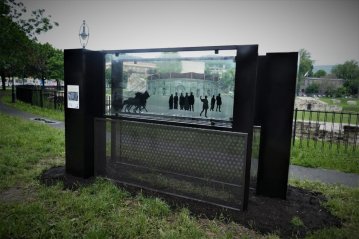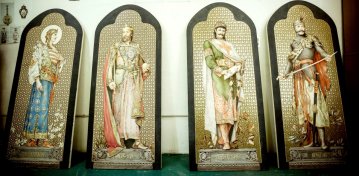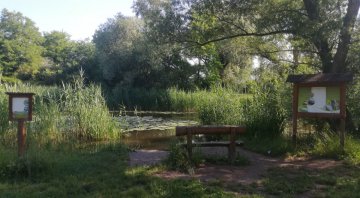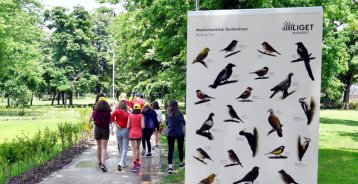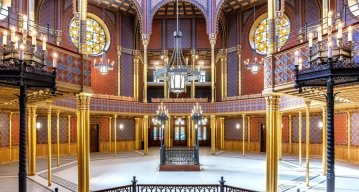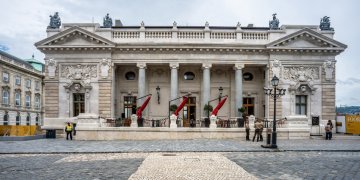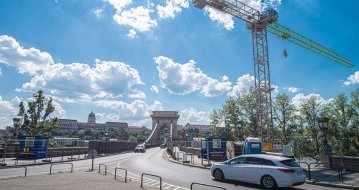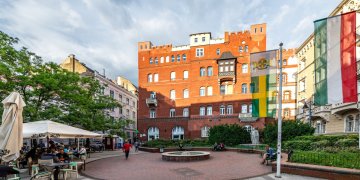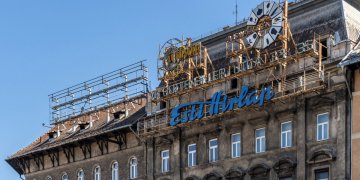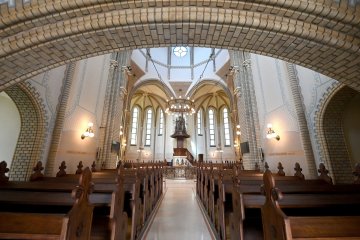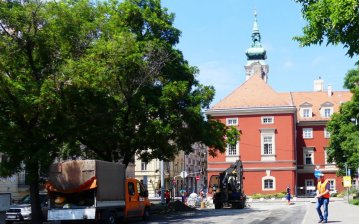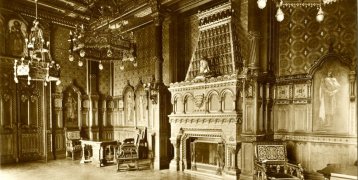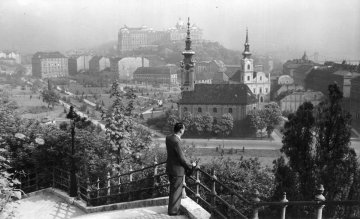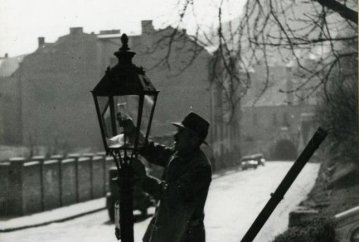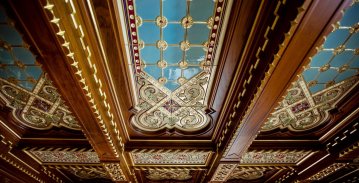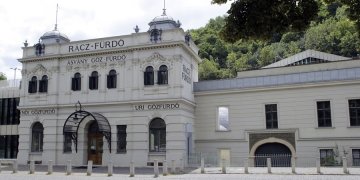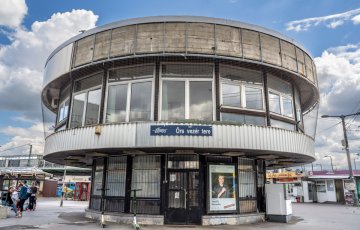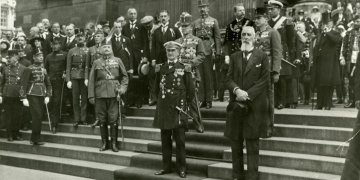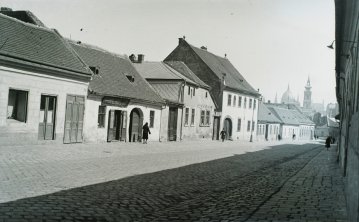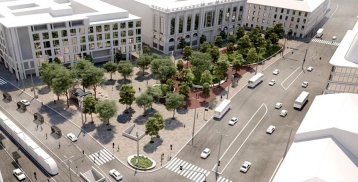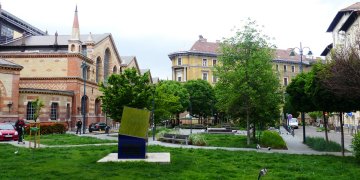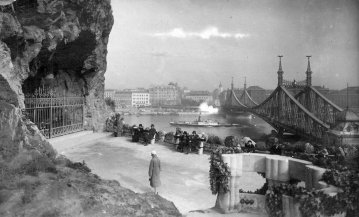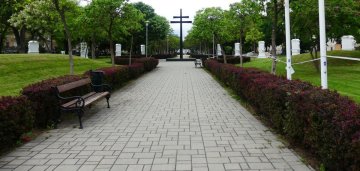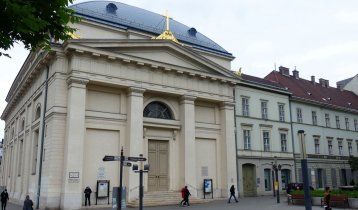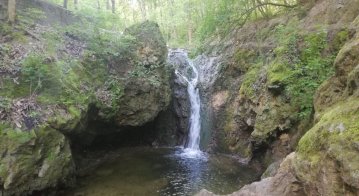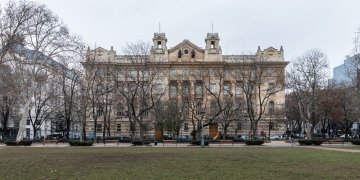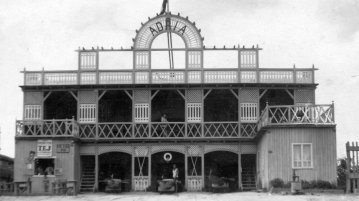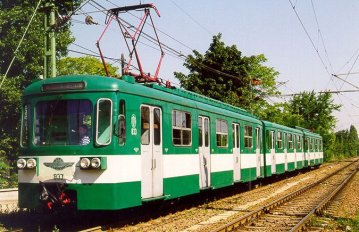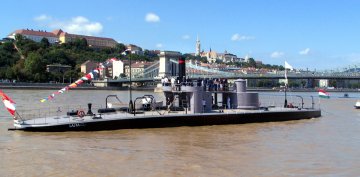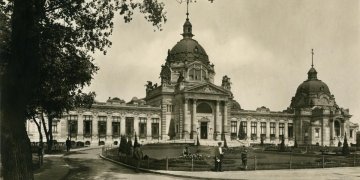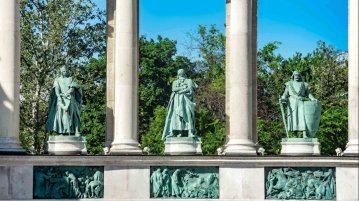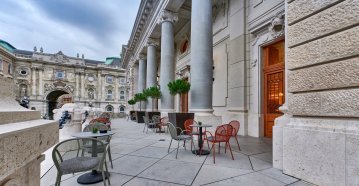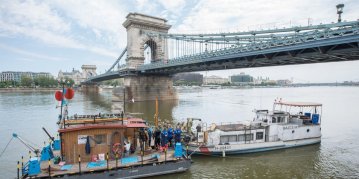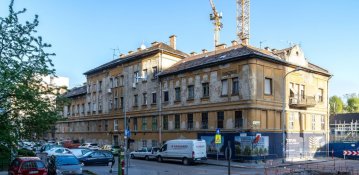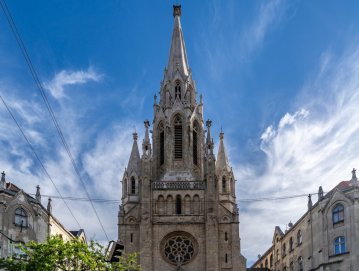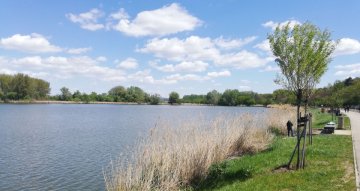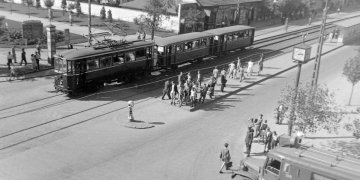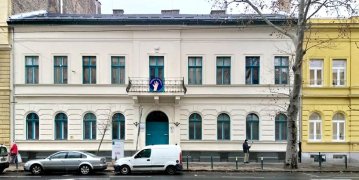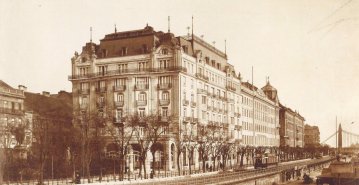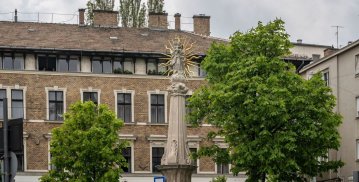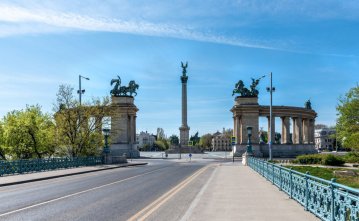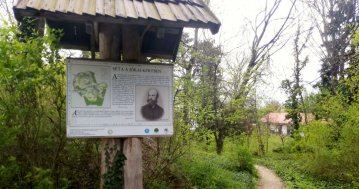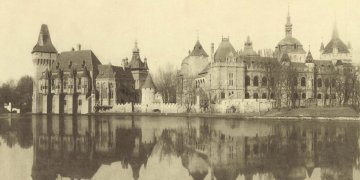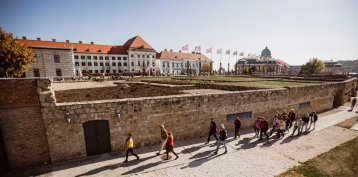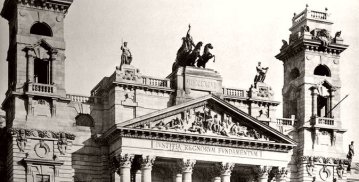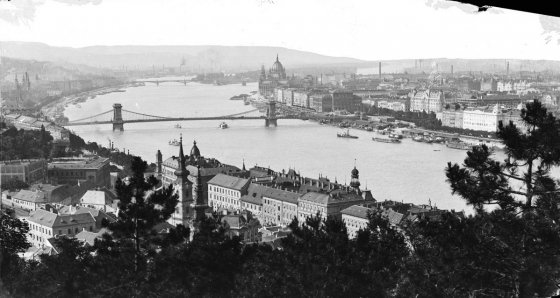 The „intertwined history” of the bridges and the city of Budapest
Which ideas and events have shaped the fate of bridges of Budapest and the cityscape? Alongside many other interesting facts, this question is also answered this newly published book by the Budapest City Archives, which introduces the history of bridges in Budapest.
The „intertwined history” of the bridges and the city of Budapest
Which ideas and events have shaped the fate of bridges of Budapest and the cityscape? Alongside many other interesting facts, this question is also answered this newly published book by the Budapest City Archives, which introduces the history of bridges in Budapest.
Search result
Roman life recreated in Óbuda
June 14, 2021 at 2:30 PM
Special reconstruction boards now allow anyone to see what life could have been like at the section of the Limes near Aquincum, now Óbuda. Two signs on the corner of Nagyszombat Street and Szőlő Street showcase the amphitheatre, the third at 7 Kórház Street, shows what the camp gate that once stood there looked like.
Painter of saints and kings – Twelve works by Ignác Roskovics adorned Saint Stephen's Hall
June 14, 2021 at 9:00 AM
Ignác Roskovics was one of the popular painters of the last decades of the 19th century and the turn of the century. Among the ecclesiastical and historical works that define his oeuvre, the twelve paintings made for the St. Stephen's Hall in Buda Castle stand out, based on which ceramic paintings were made in the Zsolnay factory. The works, ten of which depict the most important kings and saints of the House of Árpád, and two depict scenes from the life of St. Stephen, will be on display again from 20 August in the recreated St. Stephen's Hall.
Intact utensils found in a medieval well excavated under the National Guard Headquarters
June 12, 2021 at 3:30 PM
The everyday life of the former inhabitants of Buda Castle can be studied through the objects, especially the ceramic jugs and glasses, which were found during archaeological research in the area of Dísz Square – Szent György Square, on the basement level of the Honvéd ('national guard') Headquarters. Most of the finds were hidden in the depths of an identified well.
An exceptional park in an unsuspecting district
June 12, 2021 at 9:00 AM
Csepel's history is nowhere near perfect. Only three routes connect it with the rest of Budapest today, which is why it is out of sight. In recent years, something seems to have changed, and it is no longer just the panel renovation efforts making their impact: on the banks of the Ráckeve-Danube, versatile and well-designed promenades and parks await residents and visitors alike.
Educational trail unveiled in City Park
June 11, 2021 at 4:00 PM
An interactive study trail has been created in City Park in a previously neglected section, near the recently reopened Mőcsényi Mihály Botanical Garden, where visitors can learn about 335 plants and 123 bird species.
Renovated Rumbach Sebestyén Street Synagogue opened
June 10, 2021 at 4:00 PM
The renovated Rumbach Sebestyén Street Synagogue was opened as a renewed sacred, communal and cultural space. The synagogue, built in 1872 according to the plans of Otto Wagner, stood empty for decades, and its reconstruction was completed last year.
Guardians of Buda Castle – traditions of the Hungarian Royal Guards come to life in the café of the Guard House
June 10, 2021 at 10:00 AM
After almost fifty years, the Guard House (Főőrség) once again stands in full beauty on the western side of the Hunyadi courtyard. The recently opened café revives the traditions of the Hungarian Royal Guards. The exhibition on the first floor presents the history of the military unit of Hungary with the help of original uniforms, weapons, and copies of contemporary documents. The café's menu evokes the heyday of the Budapest café culture. Its interior refers to the colours of the guard's uniforms, which was one of the top Hungarian national uniforms. Pestbuda asked managing director István Bottyán about the past and present of the renewed Guard House.
Chain Bridge to be closed on 16 June – Renovation to begin in earnest
June 8, 2021 at 8:00 PM
Preparation for the renovation of Chain Bridge has reached its final stage. The 30-metre-high crane capable of lifting loads up to 30 tonnes already been assembled next to the Pest bridgehead. On 16 June the bridge will be completely closed. The bridge first opened in 1849 will be reopened to motorists next year and to pedestrians in 2023.
Fountain on Mikszáth Square under renovation
June 8, 2021 at 3:30 PM
Maintenance of the fountain last renovated in 2014, but out of operation for the past two years will begin in the middle of June.
Neons lost – Many billboards on Rákóczi Road are reminiscent of old times
June 8, 2021 at 9:00 AM
Hundreds of neon signs used to fill Budapest at night with colourful light. However, the lamps constantly needing to be maintained and wasting energy were replaced by more modern advertisements decades ago. However, many of the advertising signs or their rusty remnants can still be seen in their original place to this day, damaging the cityscape.
Renovation of Szilágyi Dezső Square Reformed Church completed
June 6, 2021 at 6:00 PM
After the external restoration carried out a few years ago, the interior renovation of the Reformed Church on Szilágyi Dezső Square has been completed. Consecrated 125 years ago, the church, designed by Samu Petz, has been given restored benches, glass windows and new floor tiles.
Changes to Batthyány Square
June 5, 2021 at 5:00 PM
The renovation of Batthyány Square aims to increase pedestrian-friendly and green areas and to better serve the needs of pedestrians, the Budapest Transport Center has announced. Due to the works, traffic rules will change in the area, and the stops of buses departing and terminating here will be moved.
"The most lavish fireplace ever made in Hungary"
June 5, 2021 at 10:30 AM
Hardly anyone would doubt that the country’s most famous fireplace stood in the St. Stephen’s Hall of the Royal Palace. Vilmos Zsolnay lived to see the making of the sophisticatedly designed and executed masterpiece made of Zsolnay majolica, but he could no longer supervise its installation: he died not long before. Lucky posterity, however, may soon admire the work destroyed after World War II, as the former masterpieces were rebuilt under the National Hauszmann Program in the reborn St. Stephen's Hall. In this article, Pestbuda looks at the behind-the-scenes of the redesigning of the fireplace.
Only a belfry reminds Budapest of the Serbian Orthodox Church that once graced the Tabán
June 3, 2021 at 2:00 PM
Today, a belfry on Döbrentei Square is the only memory of the former Serbian Orthodox Church, which was consecrated on 3 June 1751, 270 years ago. The church dedicated to Demetrius of Thessaloniki was demolished in 1949 for political reasons.
The first gas lamp in Pest was lit 205 years ago
June 3, 2021 at 9:00 AM
The aldermen of Pest were given plenty to think about when providing night lighting on the city streets in the 18th century, so in 1715, they forbade staying on the street without a candle or lantern after sunset. Lantern-bearers appeared, carrying candles and oil lamps in front of pedestrians. Oil lamps began to be put out in public spaces at the end of the century, but they only gave little light. The solution was the gas lamp, the first of which was set up in Pest by a scientist, experimenting physician, Lajos Tehel, on 5 June 1816. The lamp was lit up on the facade of the university building on today’s Egyetem Square. Now it is part of the National Museum’s collection.
Unique ceiling and parquet of Saint Stephen's Hall recreated
June 1, 2021 at 1:00 PM
The construction of Saint Stephen's Hall in the southern connecting wing of the Royal Palace of Buda Castle has entered a new phase. According to the announcement from Várkapitányság, the spectacular ceiling and parquet have been installed, and most of the custom furniture has also been completed. The next task will be to recreate the lavish wall covering
Rác Bath sold – Budapest bath operator wins auction
May 31, 2021 at 7:00 PM
The story of Rác Bath has reached another milestone, after standing empty for ten years since its renovation. During the liquidation procedure, Budapest Gyógyfürdői és Hévizei Zrt. (BGYH) was the only bidder to buy the spa and the hotel built at the starting price of about five billion HUF. However, the opening will have to wait, as the building needs further renovations.
Vehicle entry to Buda Castle first restricted 35 years ago
May 31, 2021 at 3:00 PM
Today car access to the castle is limited, and only midi-buses run within its ancient walls. Restrictions on access were introduced 35 years ago because traffic endangered historic buildings and the caves beneath the streets of the castle.
Mushroom on Örs Vezér Square to close
May 31, 2021 at 9:00 AM
Let's meet on Örs, at the Mushroom! The common sentence marks a meeting place almost as well known as the clock on the old Moszkva Square. The Mushroom once housed a traffic control centre but on 1 June 2021, even the ticket offices are closing. The fate of the building remains unknown.
A square took his name before his death – Albert Apponyi was born 175 years ago
May 29, 2021 at 3:00 PM
One of the important squares of Budapest was named after him during his lifetime. One hundred years ago, he was a hero celebrated by the whole country, on whose birthday the people of the capital filled the streets. The nation's lawyer, Albert Apponyi, born 175 years ago. He earned his title with his famous speech in the negotiations leading up to the Treaty of Trianon. Although he was considered one of Hungary's greatest statesman in his life and after his death, communism tried to make people forget him after the war. Not much is reminiscent of the once-respected politician in the Hungarian capital today.
Campaign launched against rats 90 years ago in Budapest
May 28, 2021 at 10:00 AM
A war against rats was launched in the capital in 1931, but a mistake slipped into the thorough and long-planned campaign. Fewer rats died than planned, and there were many "civilian" casualties, like dogs, cats, and birds.
Renovation of the Pest embankment to on 7 June that of Blaha Lujza Square in early July
May 27, 2021 at 2:00 PM
Two major reconstructions in Budapest will begin this summer. In a week and a half, the renovation of a section of the lower embankment of Pest between Margit Bridge and Parliament will begin. The renovation of Blaha Lujza Square is scheduled to start in July, but according to simpler designs than previously planned.
Vendors once sold their goods on Csarnok Square in Ferencváros, where shoppers and tourists now relax
May 26, 2021 at 9:00 AM
Although Csarnok (Market Hall) Square in Ferencváros did not exist before 1896, after the opening of the Central Market Hall, a busy life began on the 9th District's smallest, but all the more special square, where hundreds of graves were unearthed during a 2016 hotel construction, highlighting a small detail of the area's vibrant past.
The first statue of Saint Stephen in Budapest was completed in 1906
May 25, 2021 at 10:00 AM
The statue of Saint Stephen has been standing in Buda Castle next to the Fisherman's Bastion for 115 years. Although the founding king of Hungary has always been highly respected in the country, the great work of Alajos Strobl was completed slowly. The first statue of King Stephen in Budapest was inaugurated in 1906 next to Matthias Church almost 40 years after it was first planned.
A place of worship in a cave – Cave Church turns 90
May 24, 2021 at 2:00 PM
One might think that the Cave Church on the side of Gellért Hill is an old church, although it is surprisingly young, not a hundred years old, as construction of the chapel itself began in 1924 and it was consecrated in 1931. During the communist era, a reinforced concrete wall closed it off from worshippers, which was only demolished in 1992.
Stone column of every station standing on Golgotha Square
May 23, 2021 at 6:00 PM
Fourteen stone statues have already been erected on Golgota Square in Józsefváros. Bronze reliefs depicting the stations of the cross have been placed within them. The restoration of the stations was initiated by the Józsefváros Local Council in 2019 and is being carried out with state funding.
Lutheran church on Deák Square named National Memorial Site
May 22, 2021 at 5:30 PM
The Insula Lutherana in Budapest that is the building complex of the Lutheran church, grammar school and museum on Deák Square has been named a National Memorial Site. Supported by the government, the National Memorial and Remembrance Committee and the Institute of National Heritage, the site was listed as a memorial on 22 May 2021.
Two beautiful gorges on the border of Budapest
May 22, 2021 at 10:00 AM
Places of special beauty can be found everywhere. This time Pestbuda guides its readers to the outskirts of the capital, but that does not detract from their value. The Remete Gorge ('Hermit Gorge') and the Alsó-Jegenye Valley ('Lower Jegenye Valley') attract hundreds and thousands of people on more pleasant weekends. The tour with many attractions can be completed comfortably in a day.
Main building of the Central Bank of Hungary under renovation
May 21, 2021 at 5:30 PM
On the centenary of the founding of the central bank in 2024, the headquarters of the institution will be renovated to their original form on Szabadság Square. The building was built in 1905, its external appearance has not changed since then, but its interiors were significantly remodelled after World War II, undermining its historical value. Now its original beauty will return, inside and out.
The charming boathouses of Római-part have disappeared
May 21, 2021 at 9:00 AM
The Római-part (Roman Beach) was already a popular resting place on the Danube in the 1900s, and it became really popular in the 1920s. The former boathouses tell us about our architectural, sports and cultural-historical values – today mostly only from photographs.
Renovation of Csepel suburban railway to begin in two years
May 20, 2021 at 5:00 PM
The suburban railway line to Csepel will be extended in both directions, and the work will be carried out in several stages. In the first phase – from 2023 – a new terminal will be built in the 21st District on Erdősor Street, in parallel with the modernization of the line from the Kvassay Bridge outwards. In the second phase, the line will be connected to the Ráckeve line at the Public Slaughterhouse and extended underground to Kálvin Square. Implementation of the second phase will begin in 2024 at the soonest.
The Károlyi Palace hosted the country's first large-scale exhibition of applied arts
May 18, 2021 at 9:00 AM
Donations were raised in several places throughout the country to alleviate the damage caused by the floods of February 145 years ago and to help the flood victims. Related to these efforts was the exhibition of applied arts presenting the unique treasures of art, which was organised not in a public collection, but in the palace of Count, Alajos Károlyi built behind the National Museum in May 1876.
Most modern boat of the Austro–Hungarian Navy launched 150 years ago
May 17, 2021 at 2:00 PM
The Lajta monitor, one of the most modern warships of its time, was launched 150 years ago, on 17 May 1871. The surviving river boar of the former Austro-Hungarian Navy is now a museum. Its special feature is that the Lajta monitor is the only one in the world from the monitor type river version.
The man who drilled the artesian wells of Budapest - Vilmos Zsigmondy was born 200 years ago
May 16, 2021 at 11:00 AM
Budapest owes a lot to Vilmos Zsigmondy: the enterprising mining engineer was one of the first international experts to successfully extract thermal resources in Hungary. He drilled the artesian well of Margaret Island. The drilling of one of the deepest wells in the world at the time, almost a kilometre away, in City Park, which made it possible to open the Széchenyi Baths, is also connected to his name.
A Tuscan cast many iconic sculptures in Budapest
May 15, 2021 at 11:00 AM
Many foreign masters made a significant contribution to the development of Budapest city. Professionals from German-speaking countries excelled in the fields of architecture and applied arts in particular. A somewhat forgotten master who chose the Hungarian capital as his homeland instead of sunny Tuscany is worth noting. Raffaelo Vignali, or Rafael Vignáli in Hungarian, came to Budapest for the works of the Millennium Monument.
Café open in Guard House in Royal Palace of Buda Castle
May 14, 2021 at 3:30 PM
The Guard House (Főőrség) building opened on Friday. Visitors are invited to the cafe and an exhibition of the 260-year history of the Hungarian Royal Guards. The building designed by Alajos Hauszmann and built in 1903 originally served as the headquarters of the Palace and Royal Guards.
Divers to search riverbed near Chain Bridge for bombs and wrecks
May 12, 2021 at 6:00 PM
In connection with the renovation of the Chain Bridge, the Danube riverbed around the bridge will be cleaned. During the work, which is expected to take a month and a half, the river will be surveyed with sonar and divers in the 50-meter vicinity of the bridge. Any unspent ammunition found will be disarmed and pieces of metal removed.
Demolition: Irén Psota's birthplace to be destroyed
May 12, 2021 at 2:00 PM
Another detail of the old Budapest is set to disappear, as the demolition of the building at 23/A Tömő Street in Józsefváros will begin soon. The four-storey building, built in the 1880s, in which actress Irén Psota was born, was sold by the local council in 2019, and the new owner has already received a demolition permit.
Neo-Gothic wonder on Üllői Road – Church in Ferencváros designed by Sándor Aigner
May 10, 2021 at 9:00 AM
A large number of architects played a huge role in making Budapest a metropolis. They created numerous beautiful plans between the 1870s and 1910s. Many of our public buildings and dwellings that still stand are the fruits of their work. While this view is generally accepted, the names of several masters have almost been forgotten. Such is the case of Sándor Aigner, who designed many churches as a master of Gothic Revival architecture. His most important work is the Perpetual Adoration Church in Ferencváros.
Lake Naplás is true to its name – A place for relaxation
May 9, 2021 at 9:00 AM
The largest still water in Budapest is quite young. It was formed in 1978 during the flood protection regulation of the Szilas stream. Lake Naplás is worthy of its name, as naplás is an abbreviated form of the word napolás (to postpone), and it is worth postponing our other activities to explore the 16-hectare area and its surroundings.
Shortest suburban railway line in Budapest turns 70
May 7, 2021 at 10:00 AM
Suburban railway lines (HÉV - helyiérdekű vasút) have been running from Boráros Square to the 21st District for seventy years. Csepel had a rapid transit connection before, with trains running on Gubacsi Bridge. The suburban railway line to Csepel is record-breaking in many aspects: it is the shortest line, the site of the most serious accident, and currently home to the oldest trains.
Music school finally to move in to Damjanich Street building
May 6, 2021 at 2:00 PM
The tender for the right to rent the building at 4 Damjanich Street in Erzsébetváros has been closed. Based on the decision, the Antal Molnár Music School can move into the local council's property previously renovated for the school.
The famous line of hotels on the Danube Promenade started to develop in the year of the millennium
May 5, 2021 at 9:00 AM
Several hostels and inns awaited local and foreign guests on the banks of the Danube in Pest during the Reform period. What would become the Danube Promenade south of Chain Bridge, was a stronghold of hospitality. Most of the houses constructed in the 1870s were not originally built as hotels, and it was not until the millennium that these developments began in the area. Upscale luxury hotels such as the Grand Hotel Hungária and Bristol awaited guests at the end of the 19th century and from the 1910s, the Ritz.
The pedestal of the Mária Square memorial column is being renovated – The statue was restored last year
May 4, 2021 at 2:00 PM
The pedestal of the Mária Immaculata memorial column in Mária Square in the 1st district is being restored. The upper part of the work, along with the statue, was restored last year.
Neither Pest nor Buda wanted a private company to build the first bridge in Budapest – the bridge law is 185 years old
May 4, 2021 at 9:00 AM
A law promulgated 185 years ago made it possible to build the first permanent Danube bridge connecting Buda and Pest. A long debate preceded the adoption of the bridge law because neither Pest nor Buda supported a private company building the bridge, as they did not want to waive their customs rights.
Next steps for a car-free City Park – Planning of the new Pest overpass begins
May 3, 2021 at 4:00 PM
Another milestone towards a car-free City Park has been made. The Budapest Development Center has signed a contract to design a new overpass in Pest over the Rákosrendező railway station. It has also announced a public procurement procedure for designing a P+R car park to be built at the Mexikói road underground station.
A jewel above Budapest - The Jókai Garden has retained its charm
May 2, 2021 at 3:00 PM
Although Mór Jókai was not born and raised in Budapest, he still gave something to the capital that is irreplaceable. The garden and park he created have retained their charm to this day, despite the vicissitudes of history. The institutions here, which try to preserve Jókai's heritage, play a major role in these efforts.
Celebrating the millennial past of the Hungarian nation
May 1, 2021 at 4:00 PM
The central event of the millennium celebrations of 1896, held on the anniversary of the Hungarian Conquest of the Carpathian Basin, was the National Millennium Exhibition held in City Park. The exhibition, which was open for half a year, offered insight into the past of Hungarians and provided an opportunity to present the results achieved during the extraordinary economic development after the Austro-Hungarian Compromise.
Royal Palace of Buda Castle reopens with new guided walk and Hauszmann exhibition
May 1, 2021 at 2:00 PM
Cultural life has returned to the Royal Palace. A new, free exhibition entitled The Hauszmann Story presents the rebirth of the Buda Castle District. Visitors are also invited on a spectacular, underground adventure walk as part of the Buda Castle Walks.
Missing inscription to return to the facade of Palace of Justice
April 30, 2021 at 2:00 PM
A Latin inscription once proclaimed the judicial role of the building that stands opposite the Parliament building on Kossuth Square. Until 1949 the Palace of Justice housed the Curia, Hungary's highest court of appeal. The inscription was removed in the 1950s. During the building's renovation and the relocation of the Curia, the original inscription will return after seventy years.
 The „intertwined history” of the bridges and the city of Budapest
Which ideas and events have shaped the fate of bridges of Budapest and the cityscape? Alongside many other interesting facts, this question is also answered this newly published book by the Budapest City Archives, which introduces the history of bridges in Budapest.
The „intertwined history” of the bridges and the city of Budapest
Which ideas and events have shaped the fate of bridges of Budapest and the cityscape? Alongside many other interesting facts, this question is also answered this newly published book by the Budapest City Archives, which introduces the history of bridges in Budapest.
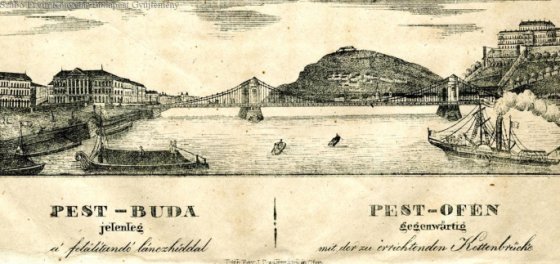 The Bridge Report, which brought a turning point in the history of Budapest
A travel report that changed the history of Pest and Buda, as well as Hungary. The little book contributed to the change of half a thousand years of legal customs and the implementation of an investment of unprecedented size and technical quality. This book was The Bridge Report [Hídjelentés in Hungarian].
The Bridge Report, which brought a turning point in the history of Budapest
A travel report that changed the history of Pest and Buda, as well as Hungary. The little book contributed to the change of half a thousand years of legal customs and the implementation of an investment of unprecedented size and technical quality. This book was The Bridge Report [Hídjelentés in Hungarian].
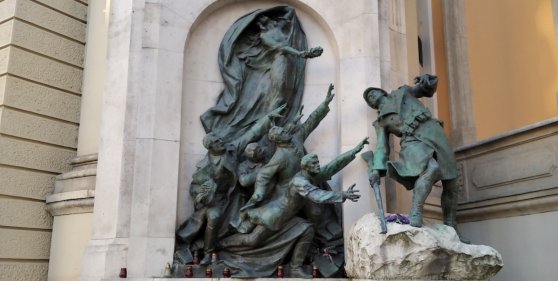 Drama on the university wall - The heroic monument was planned 95 years ago
In the constant hustle and bustle of the Egyetem Square in Pest, the students may not even notice the monument that decorates the short section of wall between the church and the central building of ELTE. However, it commemorates their predecessors, the heroes who fought for their country in World War I, and those who heroically helped them. The first design of the dramatically collapsing soldier was born in 1928, ninety-five years ago.
Drama on the university wall - The heroic monument was planned 95 years ago
In the constant hustle and bustle of the Egyetem Square in Pest, the students may not even notice the monument that decorates the short section of wall between the church and the central building of ELTE. However, it commemorates their predecessors, the heroes who fought for their country in World War I, and those who heroically helped them. The first design of the dramatically collapsing soldier was born in 1928, ninety-five years ago.

